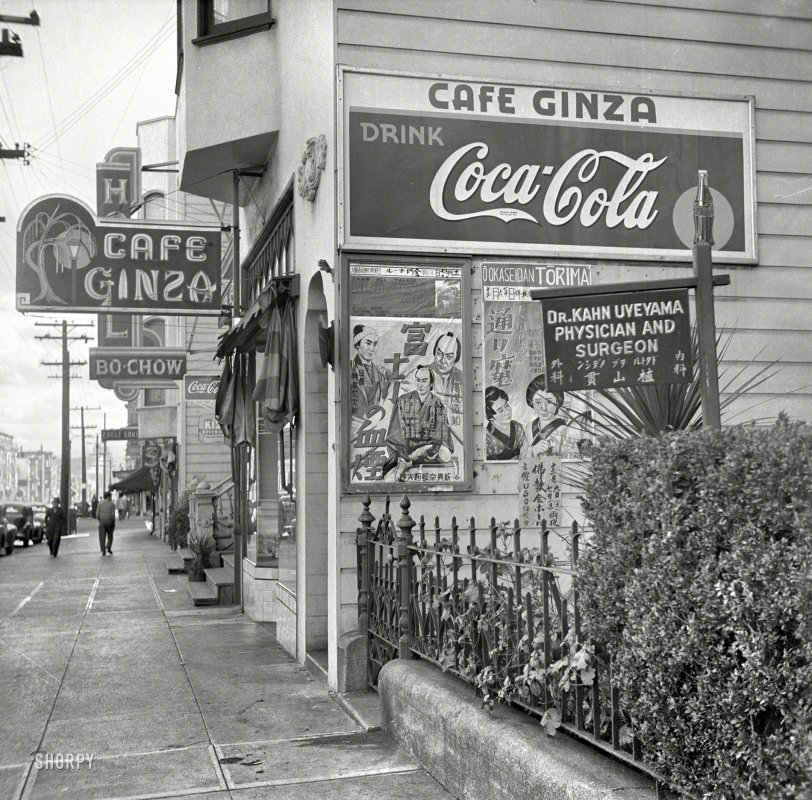


Framed or unframed, desk size to sofa size, printed by us in Arizona and Alabama since 2007. Explore now.
Shorpy is funded by you. Patreon contributors get an ad-free experience.
Learn more.

- Texas Flyer wanted
- Just a Year Too Soon
- WWII -- Replacing men with women at the railroad crossing.
- Yes, Icing
- You kids drive me nuts!
- NOT An Easy Job
- I wonder
- Just add window boxes
- Icing Platform?
- Indiana Harbor Belt abides
- Freezing haze
- Corrections (for those who care)
- C&NW at Nelson
- Fallen Flags
- A dangerous job made worse
- Water Stop
- Passenger trains have right of way over freights?
- Coal
- Never ceases to amaze me.
- Still chuggin' (in model form)
- Great shot
- Westerly Breeze
- For the men, a trapeze
- Tickled
- Sense of loneliness ...
- 2 cents
- Charm City
- What an Outrage
- Brighton Park
- Catenary Supports
Print Emporium
Cafe Ginza: 1941

San Francisco on Dec. 8, 1941. "Japanese restaurant, Monday morning after the attack on Pearl Harbor." Empires may crumble and Reichs turn to dust, but the Coca-Cola Company endures. Photo by John Collier. View full size.
Dr. Uyeyama's unfortunate neighbors
The restaurateurs who lived above the Cafe Ginza in 1940 likely ended up in internment camps. According to the 1940 census, the residents at that address were Yaneo (age 39) and Shizuko (age 34) Shimizu, identified as the proprietor and manager of a restaurant. Their names and ages match the names and birth years of internees in the Manzanar and Heart Mountain relocation centers listed in the Department of Justice's database of War Relocation Authority information. Dr. Uyeyama's other neighbors, longtime dentist Masuichi Higaki and his family, match the names and birth years of internees at the Granada relocation center in Colorado.
Re: Poster on the Left
The large picture poster on the left is for "Fujigawa no chikemuri" (1939; title means something like "Blood Spray at the Fuji River"), directed by Shichinosuke Oshimoto and starring Hideo Otani et al. The one to the right has the title in romanization (1940; Ōoka seidan tōrima), directed by Norihiko Nishina and starring Utaemon Ichikawa.
Dr. Uyeyama's family
I can find no information about whether or where Dr. Kahn Uyeyama and his family were interned during the war, but I did find that Dr. Uyeyama, a 1934 graduate and clinical faculty member at UC-San Francisco, left the U.S. Army as a lieutenant colonel in 1947. Census records from 1940 reflect that Dr. Uyeyama and his family (of 1735 Buchanan Street) were all born in the U.S., and included a four-year old son named Terry. Other military records tell of a U.S. Air Force Lieutenant Colonel Terry Uyeyama, born in San Francisco, who would have been four when that census was taken. He was interned - by the North Vietnamese as a POW from 1968 to 1973. His honors include the Distinguished Flying Cross, Legion of Merit, Silver Star, and Prisoner of War Medal.
Poster on the Left
The poster on the left is for "Niji tatsu oka", which was released in 1938. It's advertised as a "Toho All Talkie." Even in the late 1930's about one-third of the films produced in Japan were silent.
Since I don't read Japanese I can't offer anything on the other poster. The English letters at the top apparently don't refer to its title.
USO support
All of the signage is written in pre-reform style, with non-simplified characters (Japan simplified some characters after the war in 1946, though not nearly as many as mainland China did - today there are characters with three forms: the original, the PRC simplified form, and the Japan form) and with horizontal writing going from right to left. Modern Japanese horizontal writing goes from left to right (like English).
The two posters are obviously movie posters. Dr. Kahn Uyeyama (that's a common old spelling for what more modern people probably would write "Kan Ueyama") has a normal Japanese translation of his sign but also in Japanese pronunciation characters a "dokutoru obu medeshin".
The sign tacked to the bottom of the movie poster on the right says "December 6 and 7, both nights. Buddhist Community Hall sponsored, USO support event."
So yeah.
Really, the worst assault of the entire century?
Worse than Hitler? Worse than Stalin? Worse than the rape of Nanking? Worse than Mao? Worse than PolPot? Stick to photography.
Japantown (Nihonmachi)
By 1976, this area had been rebuilt with the Peace Plaza and Peace Pagoda, and the stretch of Buchanan Street in the 1941 photo was turned into a pedestrian mall. In the Street View below, the Cafe Ginza would be about mid-way up the block, on the right (it's long gone, of course, along with the Bo-Chow Hotel and the Eagle Bakery & Restaurant - this document shows how the area has changed over the years).
Street View today (as close as you can get):
Nisei Neon
Great early birthday presents to me to peer back into everyday American streets (in "Cafe Ginza" and "War News") on fateful December 8, 1941, the day exactly five years before I was born. If the Cafe Ginza's (presumably) Japanese-American proprietors were evicted and relocated during the fifth-column paranoias of 1942, I hope somebody at least rescued their neon sign, as it's fantastic. And the movie posters somehow look much later than 1941, maybe because the characters' traditionally-Japanese clothing takes away the usual Western-fashion clues we use to date such images.
Dark days ahead
Sadly, within a year most of the business owners on this street would find themselves shipped off to relocation camps in the worst assault on civil liberties in the 20th century.
Eyecatcher
That Coke bottle balanced on the signpost really gets your attention! Smart advertising.
























On Shorpy:
Today’s Top 5